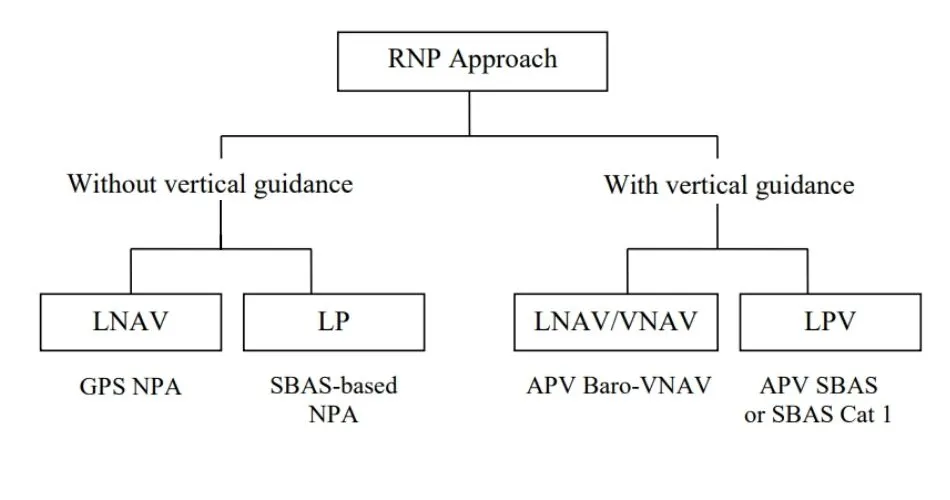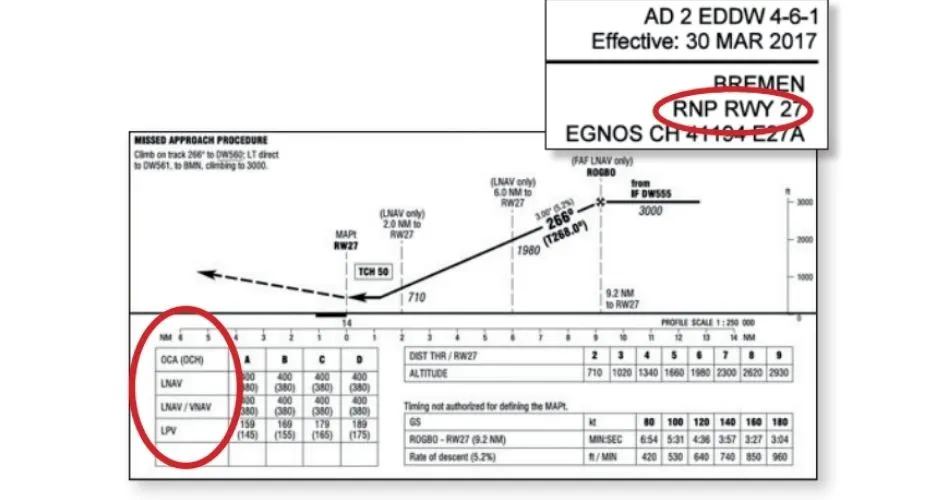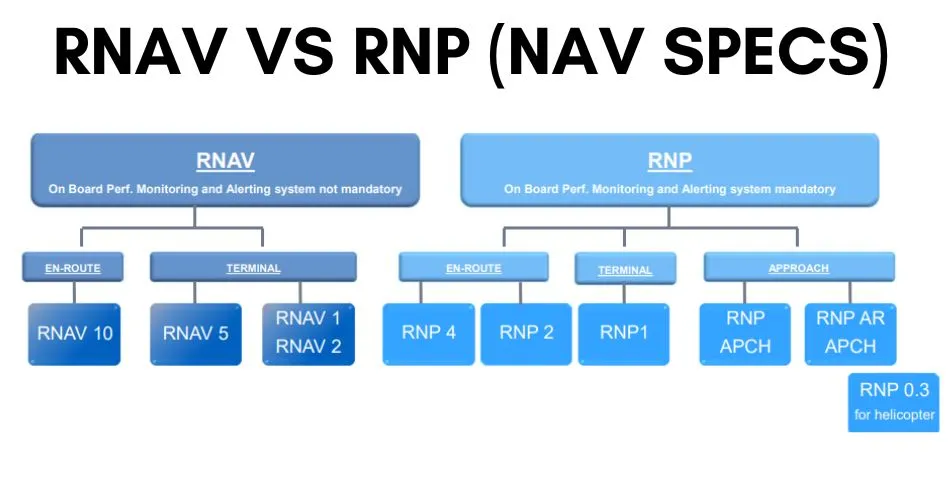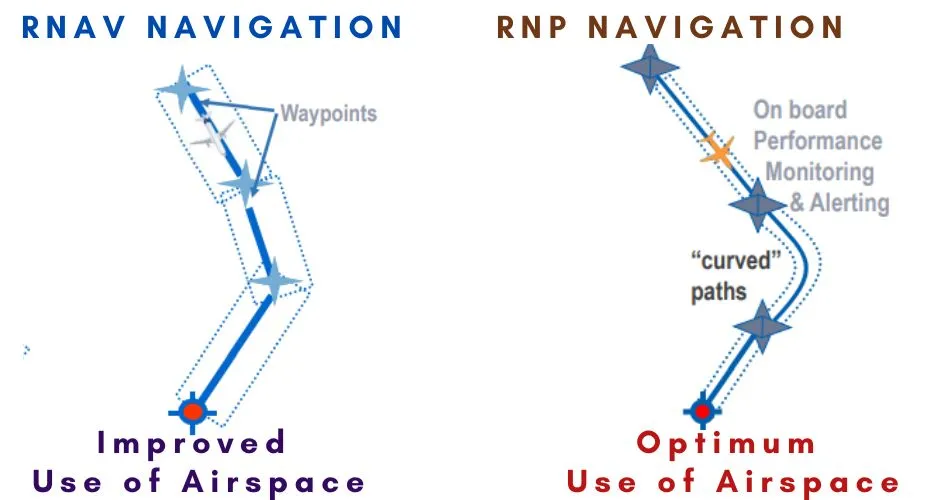Ever wondered what the RNP Approach in aviation is? We have already discussed RNAV Approach in our previous article. If you haven’t read it, we advise you to check out the technical blog which will help you to understand RNP Approach.
RNAV and RNP Approaches are related to each other because RNP is the advanced form of the RNAV Approach. Today, we will discover ‘What is RNP Approach?’ and also explore the major difference between RNAV and RNP.
Without further delay, let’s get started.
Table of Contents
What is RNP Approach? How does it work?
RNP stands for Required Navigational Performance, and it is the type of RNAV Approach with the added requirements for onboard performance monitoring and alerting (OBPMA).
The majority of flights were solely operated upon Area Navigation (RNAV) without the use of ground-based navigational aids. Now the airspace is continuously getting more and more traffic leading to optimum congestion. To mitigate the adverse consequences of air traffic congestion, and enhance airspace efficiency, RNP Approach was introduced.
Basically, RNP is a self-alerting and monitoring system equipped on board the aircraft. It alerts the pilot when the aircraft begins to drift from its tolerances which are significantly lower meaning more accuracy than a regular RNAV Approach.

RNP requirements vary depending on the phase of flight such as the arrival, in-route phase, intermediate phase, oceanic phase of flight, final approach, missed approach, departure phase, and more.
RNP Approach requires your aircraft to be equipped with the Required Navigation performance. Due to this, it can monitor the navigation performance of the aircraft and inform the pilot whether the operational requirements during an operation are met or not.
The Aircraft Flight Manual (AFM) or avionics documents for your aircraft should specifically state the aircraft’s RNP eligibilities. Contact the manufacturer of the avionics or the aircraft if this information is missing or incomplete. NavSpecs should be considered different from one another, not “better” or “worse” based on the described lateral navigation accuracy. It is this concept that requires each NavSpec eligibility to be listed separately in the avionics documents or AFM.
FAA
What are the different types of RNP Approaches?
The RNP Approach systems may differ according to the country standard, airline SOPs, and other airspace uses. However, the major types of RNP approaches are listed below with their definition.

RNP Approach (RNP APCH)
There are four minima types in aviation which are Lateral Navigation (LNAV), LNAV/VNAV (Vertical Navigation), Localizer Performance with Vertical Guidance (LPV), and Localizer Performance (LP).
RNP APCH can facilitate all these minimum levels of flight with the use of RNAV (GPS). For instance, GPS technology can provide lateral guidance to support LNAV minima. Likewise, SBAS Vertical, or Barometric Vertical offers vertical guidance to support LNAV/VNAV minima.
For LPV, or LP Minima, pilots need to navigate using a Space-Based Navigation System (SBAS). A Radius to Fix (RF) turn is not mandatory for RNP APCH.
RNP APCH may also offer a precision approach when using GBAS Landing System (GLS) constructed with RNP NavSpecs. RNP APCH has a lateral accuracy value of 1 in the terminal and missed approach segments and essentially scales to RNP 0.3 (or 40 meters with SBAS) in the final approach.
What is a Lateral Accuracy Value? It is a value represented as a distance in nautical miles from the intended centerline of a procedure, route, or path. This value is applicable to selected airspace, route, or procedure.
RNP Authorization Required Approach (RNP AR APCH)
RNP AR APCH is among the strict approaches that require special training, crew standards, and FAA authorization. This approach requires a Radius to Fix (RF) turn, and scalability.
Barometric Vertical Guidance, and SBAS Guidance are required for RNP AR APCH vertical navigation performance. This stringent approach procedure requires an aircraft to meet various requirements including design, standard operating processes, performance, training, and specific procedure design.
The Lateral Accuracy Values for RNP AR APCH can fall below 1 in the Terminal, and Missed Approach Segemntes while it can decline to RNP 0.3 or lower in the final approach.
RNP Authorization Required Departure (RNP AR DP)
RNP AR DP features the same requirements, and procedures as the RNP AR APCH. The only difference is the Lateral Accuracy Values can scale to no lower than RNP 0.3 in the initial departure flight path.
Advanced RNP (A-RNP)
The advanced Required Navigation Performance (RNP) approach is an increasingly popular navigation system in modern aviation. This NavSpec requires a minimum set of functions to be enabled within the aircraft avionics suite, such as the capability to perform RF turns and scalable RNP, as well as generate parallel offset flight paths.
Furthermore, certain airspace may require this system to have higher continuity such as dual systems, while optional options like fixed radius transitions and Time of Arrival Control can be used for en-route use.

Types of RNP Specifications
RNP 1, RNP 2, RNP 4, RNP 10, and RNP 0.3 are the specification levels designed for various flight applications listed in the table below.
| FLIGHT APPLICATION | RNP LEVEL |
| RNP AR Approach Segments | 0.1 to 1.0 |
| RNP Approach Segments | 0.3 to 1.0 |
| Terminal and En Route | 1.0 |
| En Route | 2.0 |
| Projected for Oceanic/Remote Areas where 30 Nm Horizontal Separation is applied. | 4.0 |
| Oceanic/Remote Areas where 50 N, Lateral Separation is applied. | 10.0 |
Types of RNP Approaches and their Requirement levels
| RNP APPROACHES | AIRCRAFT REQUIREMENTS & TRAINING | MINIMA | FLEXIBILITY OF TRAJECTORIES | OPERATIONS AUTHORIZATION |
| RNP AR | High (aircraft upgrade required, crews to be trained) | Medium | High (Use of RF Legs) | Heavy |
| RNP APCH | Low | Medium/High | Low | Light |
| Advanced RNP (RNP APCH with RF Legs) | Low | Medium | Medium (Use of RF Legs) | Medium |
Watch this video by Captain Joe in which he demonstrates flying an RNP Approach with the Boeing 747.
What is the difference between RNAV and RNP?
The major difference between RNAV, and RNP approaches is the operational requirements.
RNP is similar to Area Navigation (RNAV) however, it requires strict operations that comprise on-board navigation performance monitoring, and alerting capability.

RNP offers more accurate navigation than the RNAV approach. Plus, aircraft must meet the RNP operational standards, and special training must be provided to the flight crews.
On Board Performance Monitoring and Alerting System (OBPMS) is not mandatory for RNAV Approach but it is critical for RNP Approach.
RNAV 1, RNAV 2, RNAV 5, and RNAV 10 are the levels of RNAV operations. On the other hand, RNP features different levels including RNP 1, RNP 2, RNP 4, and RNP 0.3.

Another major difference between RNAV, and RNP includes the use of airspace. RNAV Approach makes improved use of airspace due to geographically defined Waypoints. In contrast, RNP makes optimum use of airspace due to the navigation system’s capability to contain aircraft position within a tunnel as shown in the figure below.
Conclusion on ‘What is RNP Approach?’
As we come to the end of this technical blog, we explored RNP Approach with its types, requirements, and differences from RNAV Approach.
In a nutshell, RNP Approach is the advanced version of the RNAV Approach that features some critical requirements to operate flights safely, and precisely.
To become eligible for RNP Approach, the aircraft must fulfill performance, design, and operational requirements. Plus, flight crews must be provided with special RNP Approach training.





